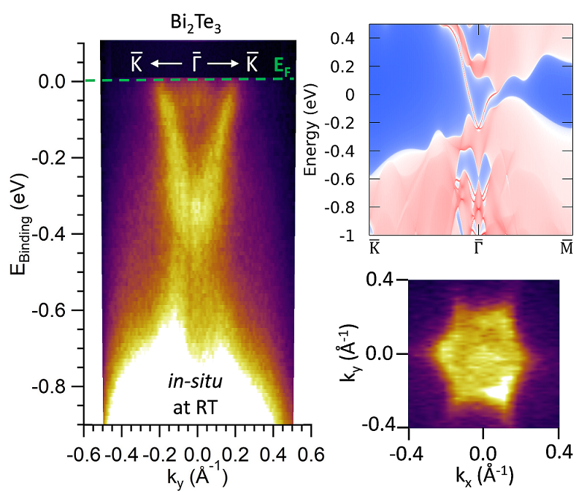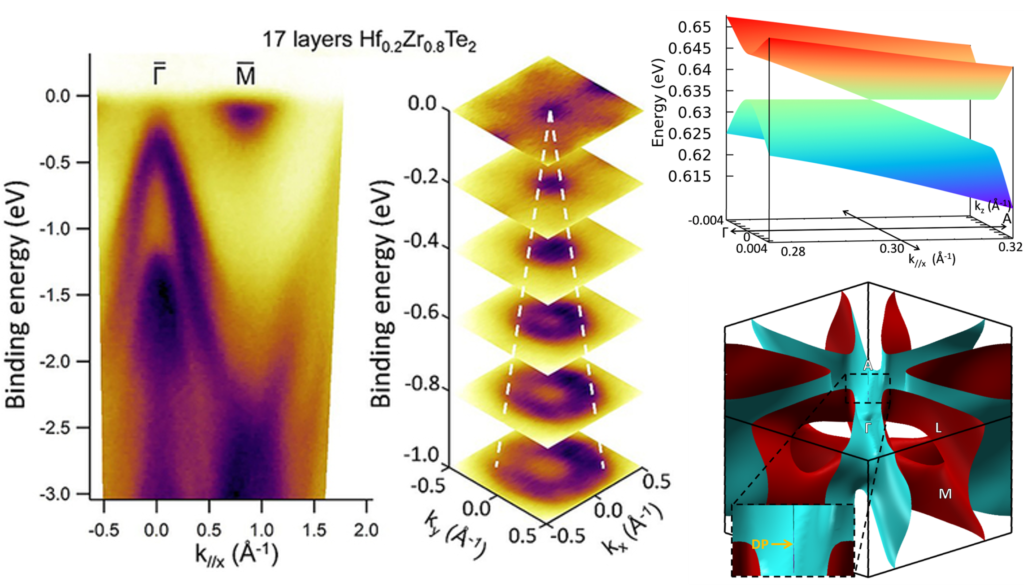Epitaxial topological 2D materials for information processing and storage
1. Background and motivation
Heterostructures combining topological insulators (TI) and topological Weyl/Dirac semimetals with magnetic layers, especially those hosting skyrmions, could lead to novel energy efficient spintronic devices for magnetic memory and logic which are currently being investigated within the H2020 FET PROACT project SKYTOP-(GA No 824123) (site: https://skytop-project.eu, twitter: @EuSkytop) led by our ESSL team. Due to the large spin orbit coupling, TI and Weyl materials potentially have a large charge to spin conversion efficiency producing spin currents able to control magnetization switching by current pulses without the use of external magnetic fields which is beneficial for device operation. Creating, destroying and manipulating skyrmions by current pulses passing through adjacent topological epitaxial layers can lead to skyrmion-based synapses for neuromorphic computing which is the ultimate goal in SKYTOP.
The advent of near room temperature 2D van der Waals metallic ferromagnets (2D-FM) CrTe2, Fe3GeTe2 (FGT) with perpendicular magnetic anisotropy (PMA) which are known to host skyrmions, open new possibilities for spintronic devices. We aim to combine these 2D metallic ferromagnets with Bi2Te3 TI in the same heterostructure. Due to the chemical and structural compatibility the two materials form clean van der Waals interfaces, facilitating the charge to spin conversion efficiency. Therefore, we expect to be able to fabricate all electrically controlled high energy efficiency spintronic devices using the novel 2D-FM/TI materials combination.
While most of the basic research and scientific discoveries in topological materials (especially Weyl and Dirac) and 2D-FM have been performed in bulk micron-sized crystals, the development of large area (cm-scale) heteroepitaxial growth by MBE will be developed at NCSRD to enable practical applications.
2.1 Epitaxial topological insulators
Topological insulators have metallic spin polarized topological surface states (TSS) where spin is locked at right angles with the momentum, so they are ideally suited for efficient charge to spin conversion in composite TI/skyrmion systems. However, most of the work on TIs is hampered by unwanted conduction from bulk since the Fermi level is typically located inside the conduction band.
Within SKYTOP, ESSL/INN develops the MBE growth of epitaxial Bi2Te3-SnTe TI compounds on InAs(111)/Si(111) crystalline substrates and subsequently investigates the electronic band structure and the Dirac cone-like TSS by in-situ ARPES, complemented by higher resolution synchrotron experiments at SOLEIL. The target is twofold: first, the TI thickness is scaled down to the few layer regime with the aim to increase the surface-to-volume ratio and maximize the contribution of TSS relative to bulk. Second, Sn composition is varied with the aim to bring the Fermi level inside the bulk band gap in which case only the TSS contribute to conduction. Particular emphasis is given to the stoichiometric compound SnBi2Te4 which is found to form septuplets in clear distinction to the parent Bi2Te3 TI which forms quintuplets. Other stoichiometric compounds, as for example SnBi4Te7, form natural van der Waals superlattices with alternating septuple/quintuple layers, increasing our options to engineer suitable TIs with the optimally TSS energy dispersion at the Fermi surface.
2. Epitaxial Weyl and Dirac semimetals
Dirac and Weyl semimetals show robust Dirac-like cones in all three dimensions in k-space so they are referred to as the “new 3D graphenes”. Weyl semimetals host chiral massless fermions with exciting new properties which is a property of their bulk rather than their surface, thus offering advantages compared to TIs. The most striking property is the existence of magnetic monopoles of the (spin) Berry curvature which is an effective magnetic field in reciprocal space. This drastically changes transport properties giving rise to the spin Hall effect and the generation of a spin current.
Within SKYTOP, ESSL/INN focuses on a number of epitaxial Weyl and Dirac semimetal candidates from the 2D TMD family. Based on our previous published work in which we showed that the Weyl type-II phase of the orthorhombic (Td) MoTe2 can be stabilized in epitaxial films on InAs(111) substrates at room temperature, we aim to improve the quality of the films using advanced Te evaporation sources and different substrates. Furthermore, we study in collaboration with our partners in SKYTOP the possible intrinsic spin Hall conductivity which has not been demonstrated in this material before. Also, leveraging from our previously published work on ultrathin epitaxial ZrTe2 and HfTe2 grown by MBE, we aim to prove within SKYTOP that these materials are topological Dirac semimetals and that they can possess an intrinsic spin Hall conductivity. Additional studies of their electronic and thermoelectric transport properties are conducted within the H2020 MSCA-ITN project SMART-X (GA No 860553) (site: https://www.smartx-itn.eu/) and the FLAG-ERA project MELoDICA (site: http://www.melodica.spin.cnr.it/).
3. 2D van der Waals metallic ferromagnets
Within SKYTOP we have developed the growth of CrTe2/Bi2Te3 and FGT/Bi2Te3 heterostructures by molecular beam epitaxy. In collaboration with CNRS and THALES, we have demonstrated that the heterostructures show hard magnetic properties, out of plane (PMA), with nearly square loop hysteresis verified by a strong anomalous Hall effect. In CrTe2, indirect evidence of skyrmions is obtained below 100 K via the topological Hall effect (THE). A large field-like torque and clear magnetization reversal induced by 10 mA/100 μsec current pulses is also observed in CrTe2/Bi2Te3 and FGT/Bi2Te3 making them good candidates for all-electrical control of information stored in the magnetization the 2D-FM layer. Our plans for the next two years focus on the room temperature operation of the 2D-FM/TI devices. We have already grown epitaxial Fe-rich FGT material and by using our newly installed Kerr microscopy and magnetometry we have verified that this material has strong ferromagnetic properties well above 300 K. This is a first step towards realizing room temperature 2D-FM/TI spintronic devices which is expected to be a big accomplishment, in line with our research plans.


